Video games have come a long way since William Higinbotham unleashed the very first video game upon the world way back in 1958. Back then it was just an interesting curiosity, but now it’s hard to imagine a time where video games weren’t ever present in our daily lives. From the comfort of our couches to the portability of our mobile devices, most of us have enjoyed video gaming at some point in time or another.
During your video game experiences, you might have come across the term “MOBA”. You might have even played one of these games at some point in time. However, if this is a new concept to you, fellow writer Elijah Longwell described just what a MOBA is very well in his Battle For Biternia review. Here’s how he describes it:
“If you’re not familiar, MOBA stands for Multiplayer Online Battle Arena. In these games, two teams play in a real time, head to head, arena where they try to destroy the other team’s base. Each team member gets to pick a unique character that plays differently than all of the rest. Both teams try to outplay the other team by defeating their characters and turrets (which block the paths) and outpacing them in leveling up their characters. The more characters they destroy, the quicker they get to level up and get new abilities and items. The most common MOBAs you’ll see out there are games like League of Legends, Dota 2, and Heroes of the storm.”
Reggie Games’ ELO Darkness attempts to capture the look and feel of one of these games in an analog format. Does it succeed? Read on to find out more.

Overview
In the game of ELO Darkness, two players will battle it out head-to-head or four players will battle it out in a two-on-two battle to be the first to advance across the map and take over their opponents’ base. Each player (or team) has their own pre-constructed deck of cards which will assist them in this process. These cards will help them to earn the money that they need to acquire items, to deploy and command the heroes that they control, and to fight battles as they advance towards their goal. Along the way, the heroes will level up making them even more powerful.
Contents
ELO Darkness has changed quite dramatically since its first Kickstarter debut. Originally clocking in at just shy of 150 cards in total, the game now includes a little over 400 of them! They are divided into several types: hero, item, action, roaming/free lane, monster, and hero draft cards. There are also a number of various tokens included which represent various things such as money, locations, classes, influence, and whose turn it is. In addition to all of this is the game board. The prototype copy that I received includes the 1 vs 1 board only, but the final version is slated to have a double-sided board which will also have a 2 vs 2 option on the reverse side.

Since this is just a prototype, I cannot comment on the final quality of the game, but I can tell you that what I have received not only looks very nice but it’s also of pretty decent quality as well. The cards are very durable and came to me pre-sleeved. The tokens, for the most part, are of a decent thickness which makes them easy to pick up. The rulebook is well made and well written. Everything about this prototype is clear evidence that a lot of love and effort was put into making it the best prototype that it could possibly be. The respect for the product shows.
Now, if you’re just interested in hearing what I think about the game, feel free to scroll down to the Thoughts section. However, if you’d like to know how this machine runs, then keep reading. In this review, I am going to focus my attention on the 1 vs 1 experience since I have not played a 2 vs 2 game yet.
Setup
Before you can begin playing ELO Darkness, you first need to construct your deck. If you’ve ever played a game like Magic: the Gathering before, you’ll know that deck construction can be a very time-consuming process. I cannot give you any real advice in this regard. No doubt there will be entire discussion groups dedicated solely to ELO Darkness deck theory at some point in the future. Fortunately, the designers have provided the players with some suggested decks. Each deck is comprised of 40 cards each and contain a mixture of generic action cards and hero specific cards. Players also receive 3 Roaming/Free Lane cards and an Item deck which consists of 5 different magical items.
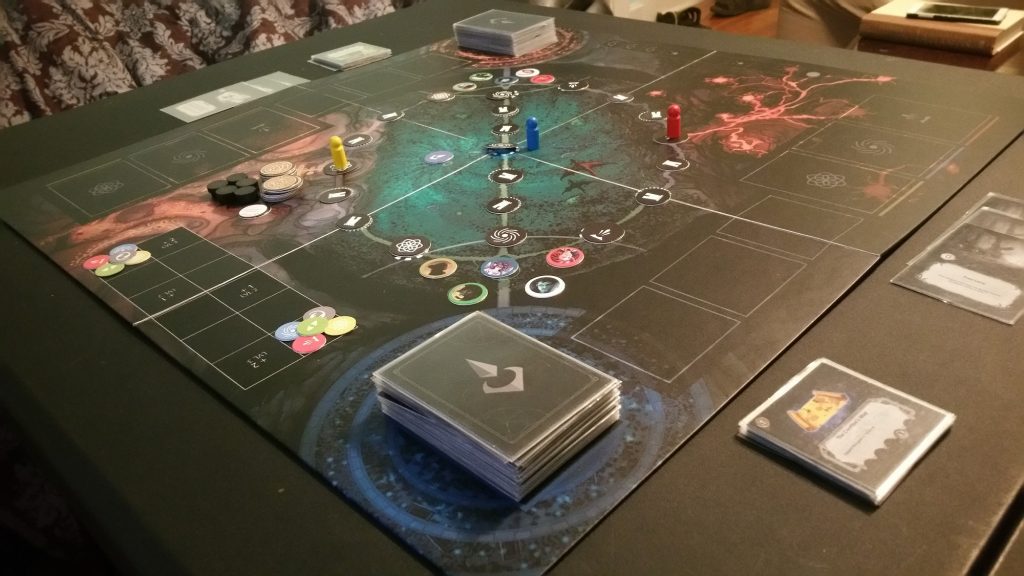
From this point on, the setup for the game is fairly easy. Set the game board onto the table and then set your respective decks into their “Base slots”. The character tokens are placed into their appropriate spots; the Laner heroes (rest assured, this and other weird terminology will be explained in due time) are placed above their respective “Laner slots” while the Jungler and Support Heroes are placed into the “Gank area”. The class tokens are placed onto the first step of the experience table.
Next, the players place their item decks as well as their roaming/free lane cards next to the board along with the gold, greedy, influence, and monster tokens. The towers and minion tokens are placed onto the board following the layout in the rule book. One player will be blue and the other orange. The turn token is flipped and placed onto the turn track on the game board. Whichever color it displays determines who will be the first player. Now you’re ready to dive in.
The Heroes
Each player begins the game with a deck of cards that is made up of 5 different hero classes. Each hero has 5 cards associated with it, so 25 cards out of your 40 card deck are going to be hero cards. These hero cards are divided into two types, Laner and Gank. The game board is divided into several key areas: bases, lanes, Laner slots, the turn track, the Gank areas, and the level up table. There are three different types of lanes – desert, forest, and volcano – and each player’s deck will have one hero that is associated with each of these – the Laners. The other two heroes will be Ganks and these can be used on any lane during the combat phase of the game.
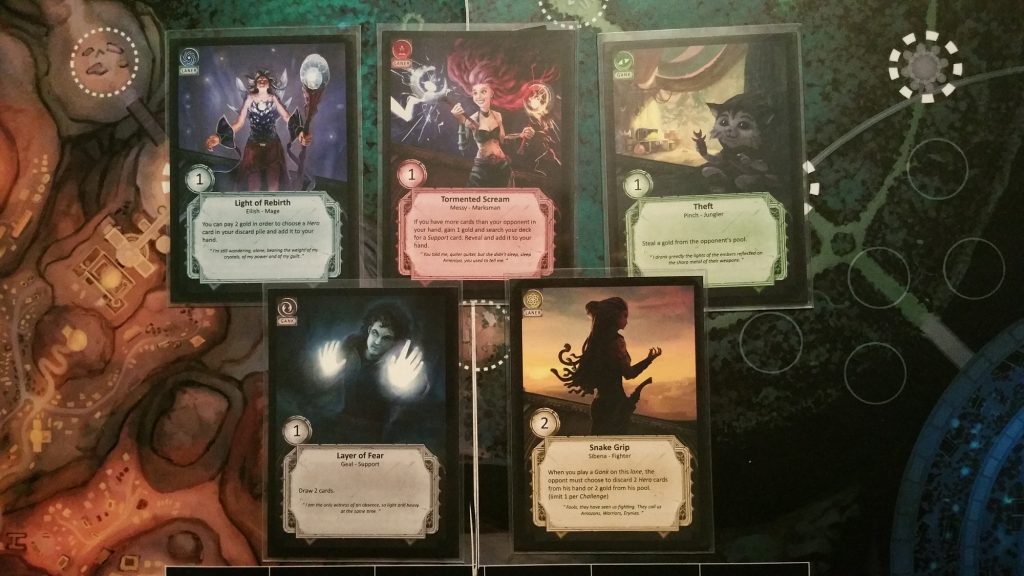
Each hero has an associated influence value which is shown on the left-hand side of the card. This represents the hero’s strength in battle. At various points during the game, the heroes will gain experience which will increase the base influence that they bring to battles. Each hero card also has a built-in ability which fires off whenever the card is played.
The Phases
Each round of the game takes place over several phases: the farming phase, the backing phase, and the combat phase. During the farming phase, players may choose to discard hero cards from their hands in order to gain gold, draw new cards, and gain experience. It is in this phase that the players may also purchase items from their Item deck. These purchased items are kept in the “item slot” on the game board and there can only ever be 3 items in play per player at any time during the game.
During the backing phase, the players will have the opportunity to retreat on one or more lanes. If a player retreats from a lane, they will be able to draw a card from their deck. Retreating also cancels any combat on that lane for the turn. The hero that would normally be associated with that lane gains the Gank trait for the remainder of the turn. So, a player might decide to retreat because they know they can’t win a combat on the lane for that turn and would rather use those hero cards on a different lane or they might just need to draw an extra card.

This is followed by the combat phase. During this phase, the players will deploy their Laner cards to the appropriate laner slots face down. If a player does not have a valid Laner card in their hand, they must mark the lane with a Free Lane card. Once all players have assigned cards to the lanes, the cards are revealed and combat is resolved.
Combat is resolved by comparing the influence that each player has brought to the battle. The hero cards all have a default influence value, but the players can play Gank cards and chain hero cards together in order to increase this value. The player that brings the most influence to the fight wins and they will advance the minion token on that lane towards their opponent’s base. They also get to give an experience point to all of their heroes that were used during the combat. If they overrun a tower, the tower is removed from the board and the winner gets to draw a card or gain a gold.The losing player will lose at least one of their hero tokens which will make it unusable for the next turn.
Things continue in this fashion until one of the players manages to invade their opponent’s base.
Thoughts
A challenge for any video-game-turned-board-game is to not only stay true to the source material but to also maintain the look and feel of it. Part of the reason MOBAs and first-person shooters are so popular is that they require a lot of skill to do well at them and they play very rapidly. This doesn’t translate so well to board games. Whereas everything in a video game is handled for you behind the scenes by the computer, the pieces and components in board games require a more hands-on approach. The amount of piece shuffling required is sometimes referred to as the game’s “fiddliness”. In a game that is attempting to emulate a video game style that is action packed and rapid fire, it is essential to eliminate as much of the board game’s inherent fiddliness as you possibly can. ELO Darkness has managed to do this… for the most part.

There are a few aspects of the game that just seem superfluous and unnecessary; for instance, consider the hero leveling system. Just because a person might have spent decades of their life training in martial arts doesn’t make them invulnerable. It just means that they’re better suited to respond in certain situations. This is thematically translated in most video games by allowing characters to learn new abilities and gain access to new gear and equipment as they increase in levels. At the hero’s core, though, they’re still vulnerable; without their gear, they’re still relatively weak. Leveling your hero in ELO Darkness doesn’t unlock any new abilities or give access to any new equipment. It just adds a single digit modifier to your base combat. This just feels flat and unexciting. I wish that the hero cards had multiple effects to choose from the higher your hero’s level was. That would present the gamer with interesting options as well as an impetus to want to level their heroes as fast as possible. The system as it is now just doesn’t feel like it’s really needed.
Another component that feels unnecessary is the turn track events. For instance, at the beginning of the 4th and 7th turns, a monster card is revealed. When this happens, the players count up the number of cards that they currently have in their hands and take one monster token per card. Then the players secretly bet a number of tokens. The player that bets the most gets to add the monster card to their deck, but they have to discard a number of cards equal to whatever they bet. This just doesn’t feel like it fits into the game thematically. A MOBA is all about constantly being on the attack and trying to overcome your opponent’s defenses in order to storm their base. A gambling mini-game dropped into the middle of an action-packed battle just doesn’t make any sense.
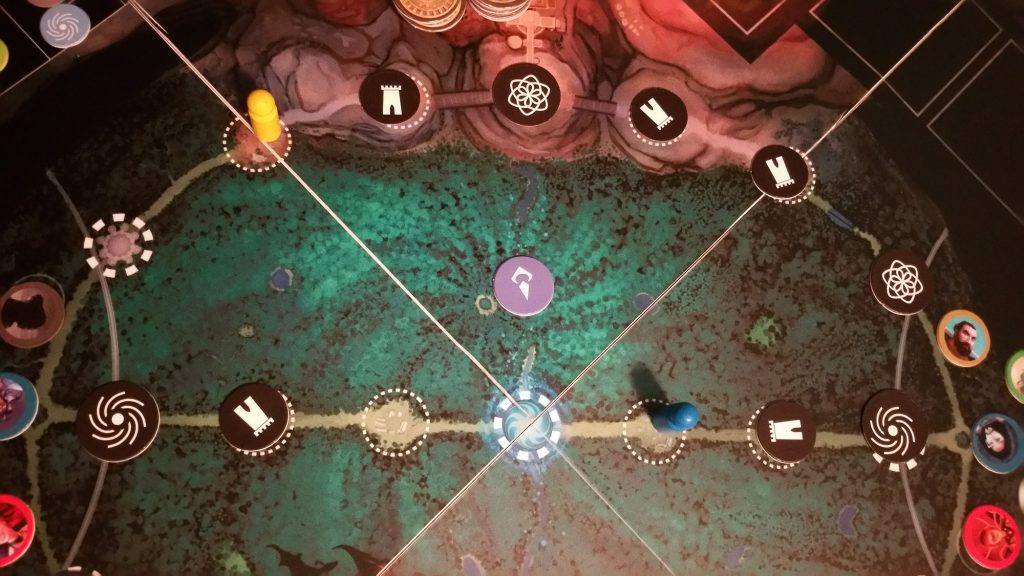
Something else that I worry about as far as this game is concerned is the concept of pre-constructed deck building. This kind of thing works for games like Magic: the Gathering because the people that play those types of games typically play ONLY those particular games. A Magic: the Gathering player won’t bat an eye at having to constantly build and rebuild their deck. Fine-tuning your deck in order to be more competitive is half the fun of that game. When you sit down to play a game of Magic, you’re usually going to find yourself sitting across from another seasoned veteran of the game. This is not usually the case with board gaming. The reason that the board gaming 10 x 10 challenge (that is a challenge wherein gamers will create a list of 10 games and challenge themselves to play each of them at least 10 times over the course of the next year) is challenging is that board gamers very rarely play the games in their collections 10 times. I can look at my collection of several hundred games and point to just a handful that have seen that many plays.
ELO Darkness is asking players to dedicate a lot of their gaming time solely to this game. You are expected to custom build a deck and test it out over and over again until it’s a fine-tuned machine. For me, personally, this is an unrealistic expectation. I doubt that I would ever get the game to the table often enough to ever custom build a deck and make it any good and I also doubt that I would ever get the game to the table with another single person that is just as dedicated to the game as I am. But that’s just me. I recognize that not everybody out there has a massive collection of games to choose from. And that isn’t me bragging. I’ve been playing board games for quite some time now and I’ve accumulated quite a few over the years. If ELO Darkness is your very first board game or just one of very few, then it’s an excellent game to add to your collection. I know that you might not believe it judging by my previous comments, but it’s actually a pretty good game. So, let’s talk about the positives.
For starters, the game looks amazing. The bright and vivid colors of the cards really pop against the dark and moody backdrop of the game board. The illustrations are bold and action-packed and definitely engender a sense of excitement and anticipation. Even the rulebook is eye-catching. As far as looks and presentation go, there’s nothing to dislike about this game.

Despite the few unnecessary elements that I spoke about earlier, the game actually moves at a well-paced clip. The turns happen fairly quickly and there’s a good back and forth between the players which always has you feeling engaged in the actual goings on of the game. ELO Darkness also emulates the constant struggle that you experience when playing an actual MOBA as the minion tokens are pushed back and forth up and down the various lanes. One moment you’re trying to stave off an invasion from the desert lane and the next you’re having to fend off an invasion from the forest lane. Inevitably the momentum will eventually become too much for one player to fend off and they will get overrun bringing the game to an end. It’s actually pretty fun to play and I have enjoyed playing it.
However, I don’t see it finding a permanent home in my collection. I like games where I have a lot of options and a lot of interesting choices to make. ELO Darkness, though, basically comes down to luck of the draw. If you’ve got a decent hand of cards this round, you’re going to do well most likely. If not, then you’re going to lose some ground and there isn’t much to be done for it. If you like a little chaos and unpredictability in your games, then ELO Darkness might be right up your alley. Regardless of how I personally feel about the presence of or lack of chaos in my games, I will say this: ELO Darkness is definitely a game worth checking out.




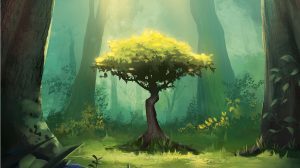

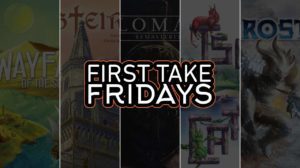




Add Comment